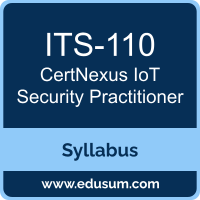 Use this quick start guide to collect all the information about CertNexus CIoTSP (ITS-110) Certification exam. This study guide provides a list of objectives and resources that will help you prepare for items on the ITS-110 CertNexus Certified Internet of Things Security Practitioner exam. The Sample Questions will help you identify the type and difficulty level of the questions and the Practice Exams will make you familiar with the format and environment of an exam. You should refer this guide carefully before attempting your actual CertNexus IoT Security Practitioner certification exam.
Use this quick start guide to collect all the information about CertNexus CIoTSP (ITS-110) Certification exam. This study guide provides a list of objectives and resources that will help you prepare for items on the ITS-110 CertNexus Certified Internet of Things Security Practitioner exam. The Sample Questions will help you identify the type and difficulty level of the questions and the Practice Exams will make you familiar with the format and environment of an exam. You should refer this guide carefully before attempting your actual CertNexus IoT Security Practitioner certification exam.
The CertNexus CIoTSP certification is mainly targeted to those candidates who want to build their career in Internet of Things domain. The CertNexus Certified IoT Security Practitioner (CIoTSP) exam verifies that the candidate possesses the fundamental knowledge and proven skills in the area of CertNexus IoT Security Practitioner.
CertNexus CIoTSP Exam Summary:
| Exam Name | CertNexus Certified IoT Security Practitioner (CIoTSP) |
| Exam Code | ITS-110 |
| Exam Price | $367.50 (USD) |
| Duration | 120 mins |
| Number of Questions | 100 |
| Passing Score | 60% |
| Books / Training | ITS training |
| Schedule Exam | Pearson VUE |
| Sample Questions | CertNexus CIoTSP Sample Questions |
| Practice Exam | CertNexus ITS-110 Certification Practice Exam |
CertNexus ITS-110 Exam Syllabus Topics:
| Topic | Details | Weights |
|---|---|---|
| Securing IoT Portals |
- Identify common threats used to compromise unsecure web, cloud, or mobile interfaces.
- Implement countermeasures used to secure web, cloud, or mobile interfaces.
|
29% |
| Implementing Authentication, Authorization, and Accounting |
- Identify common threats used to exploit weak authentication/authorization schemes.
- Implement countermeasures used to provide secure authentication, authorization, and accounting.
|
14% |
| Securing Network Services |
- Identify common threats used to exploit unsecure network services.
- Implement countermeasures used to provide secure network services.
|
14% |
| Securing Data |
- Identify common threats used to exploit unsecure data.
- Implement countermeasures used to secure data.
|
14% |
| Addressing Privacy Concerns |
- Identify common threats used to compromise privacy.
- Implement countermeasures used to ensure data privacy.
|
12% |
| Securing Software/Firmware |
- Identify common threats used to exploit unsecure software/firmware.
- Implement countermeasures used to provide secure software/firmware.
|
10% |
| Enhancing Physical Security |
- Identify common threats used to exploit poor physical security.
- Implement countermeasures used to ensure physical security.
|
7% |
To ensure success in CertNexus IoT Security Practitioner certification exam, we recommend authorized training course, practice test and hands-on experience to prepare for CertNexus Certified Internet of Things Security Practitioner (ITS-110) exam.
